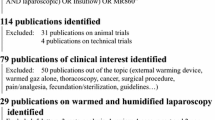Abstract
Background
The use of intraoperative carbon dioxide (CO2) colonoscopy during a laparoscopic colon operation is becoming more common. Simultaneous intracolonic and intraabdominal CO2 insufflation may result in significant physiologic changes, but in-depth physiologic effects have not been studied to date. This study aimed to evaluate the physiologic changes and the overall safety of simultaneous CO2 laparoscopy and colonoscopy.
Methods
A prospective pilot study was performed with 26 subjects (17 men and 9 women) undergoing laparoscopic surgical treatment for colorectal conditions adjunctively managed with CO2 intraoperative colonoscopy. Surgery proceeded with CO2 insufflation to a maximum pressure of 12 mmHg by laparoscopy and with a maximum CO2 flow of 5 l/min via colonoscopy. Serial intra- and postoperative arterial blood gases, end-tidal CO2, and minute ventilation were recorded during predetermined periods: during initial laparoscopy, during simultaneous colonoscopy and laparoscopy, during laparoscopy after colonoscopy, and after desufflation.
Results
No significant morbidity resulted from simultaneous CO2 insufflation. Three patients had a CO2 partial pressure (PaCO2) greater than 50, and one patient with a body mass index (BMI) higher than 42 kg/m2 had a PaCO2 greater than 50 for more than 30 min and was compensated by increasing minute ventilation. The mean pH was 7.36 in the recovery room. Postoperatively, no patient had a pH lower than 7.3, prolonged intubation, or reintubation.
Conclusion
Simultaneous CO2 colonoscopy and laparoscopy lead only to transient alterations in respiratory parameters that can be compensated. Based on these findings, simultaneous insufflation of CO2 into the peritoneal cavity and the large bowel lumen during complex endoscopic procedures may be considered safe for most patients.


Similar content being viewed by others
References
Hussein AM, Bartram CI, Williams CB (1984) Carbon dioxide insufflation for more comfortable colonoscopy. Gastrointest Endosc 30:68–70
Stellato TA (1996) Flexible endoscopy as an adjunct to laparoscopic surgery. Surg Clin North Am 76:595–602
Rogers BH (1974) The safety of carbon dioxide insufflation during colonoscopic electrosurgical polypectomy. Gastrointest Endosc 20:115–117
Nakajima K, Lee SW, Sonoda T, Milsom JW (2005) Intraoperative carbon dioxide colonoscopy: a safe insufflation alternative for locating colonic lesions during laparoscopic surgery. Surg Endosc 19:321–325
Wax DB, Lin HM, Hossain S, Porter SB (2010) Intraoperative carbon dioxide management and outcomes. Eur J Anaesthesiol 27:819–823
Bretthauer M, Thiis-Evensen E, Huppertz-Hauss G, Gisselsson L, Grotmol T, Skovlund E, Hoff G (2002) NORCCAP (Norwegian colorectal cancer prevention): a randomised trial to assess the safety and efficacy of carbon dioxide versus air insufflation in colonoscopy. Gut 50:604–607
Lipof T, Bartus C, Sardella W, Johnson K, Vignati P, Cohen J (2005) Preoperative colonoscopy decreases the need for laparoscopic management of colonic polyps. Dis Colon Rectum 48:1076–1080
Church JM (2003) Avoiding surgery in patients with colorectal polyps. Dis Colon Rectum 46:1513–1516
Franklin ME Jr, Leyva-Alvizo A, Abrego-Medina D, Glass JL, Trevino J, Arellano PP, Portillo G (2007) Laparoscopically monitored colonoscopic polypectomy: an established form of endoluminal therapy for colorectal polyps. Surg Endosc 21:1650–1653
Acknowledgment
The authors acknowledge Dr. Kevin Morrissey, Clinical Associate Professor at Weill Medical College of Cornell University-New York Presbyterian Hospital, for editing this article. The authors also thank Miss Yuko Tonohira, medical illustrator at the same institution, for providing the illustrations for this article.
Disclosures
Jeffrey W. Milsom received course support from Olympus, Covidien, and Applied Medical, and research support from Olympus. Sang W. Lee received course support from Olympus, Covidien, and Applied Medical and research support from Covidien. Toyooki Sonoda received course support from Olympus, Covidien, and Applied Medical and research support from Adolor. Koiana Trencheva, Panchali Dhar, Jon Samuels, and Brenna Stein have no conflicts of interest or financial ties to disclose.
Author information
Authors and Affiliations
Corresponding author
Additional information
Koiana Trencheva and Panchali Dhar equally contributed to this article.
Rights and permissions
About this article
Cite this article
Trencheva, K., Dhar, P., Sonoda, T. et al. Physiologic effects of simultaneous carbon dioxide insufflation by laparoscopy and colonoscopy: prospective evaluation. Surg Endosc 25, 3279–3285 (2011). https://doi.org/10.1007/s00464-011-1705-2
Received:
Accepted:
Published:
Issue Date:
DOI: https://doi.org/10.1007/s00464-011-1705-2




